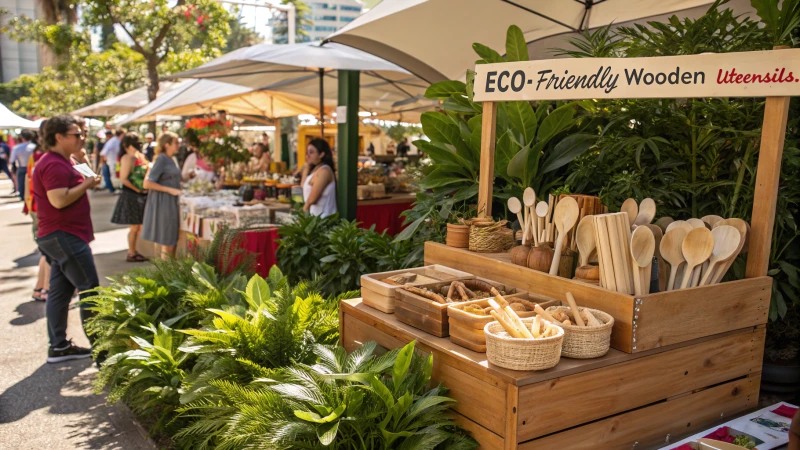
Ever wondered why some markets embrace disposable wooden cutlery while others stick to plastic?
Cultural influences like eco-awareness, dining customs, and local laws shape how disposable wooden cutlery is embraced in various markets. Understanding these factors helps businesses adapt their approach for successful entry and customer acceptance.
Reflecting on my own journey, I've seen firsthand how culture shapes our choices, even in something as simple as cutlery. In some places, the shift to wooden alternatives is almost a given, driven by a strong environmental ethos. I remember chatting with a friend in a café, where even the spoons echoed the green values we hold dear. Yet, in other regions, tradition holds sway, with folks sticking to familiar utensils despite the growing environmental call.
Diving deeper into this topic, it's fascinating to see how regulatory frameworks play a pivotal role. Like when I visited a bustling street market and noticed how local laws had nudged vendors towards greener options. Each market's unique cultural tapestry not only dictates consumer preferences but also highlights untapped potential for businesses willing to navigate these nuances. By understanding these dynamics, we can craft strategies that resonate with local sensibilities and foster broader acceptance of eco-friendly products.
Environmental consciousness boosts wooden cutlery adoption.True
Markets with high environmental awareness are more likely to adopt eco-friendly products.
Traditional dining habits hinder wooden cutlery use.True
Regions with strong traditional dining practices may resist switching to disposable options.
How Does Environmental Awareness Influence Cultural Practices?
Imagine a world where every culture dances to the rhythm of nature, each step a nod to environmental consciousness. Let's explore how different societies embrace sustainability.
Environmental awareness weaves into cultural values, guiding behaviors and practices. From traditional wisdom to modern sustainability efforts, each culture uniquely engages with ecological challenges, showcasing its special bond with nature.

Cultural Influence on Environmental Practices
I’ve always been fascinated by how cultures weave their values into everyday life, especially when it comes to caring for our planet. Take Japan, for instance. The Japanese have this beautiful concept called 'mottainai' that’s all about minimizing waste and maximizing resources—a principle deeply ingrained in their culture and daily habits. It’s not just about recycling; it’s a lifestyle of respect for resources.
Similarly, Nordic countries are like the rock stars of sustainability. I remember reading about how they’ve managed to incorporate eco-friendly policies into everything from public transport to energy consumption, making green living almost second nature to their citizens. It’s inspiring to see how policy and personal responsibility can go hand in hand.
| Culture | Environmental Practice |
|---|---|
| Japan | Mottainai (Reduce Waste) |
| Nordic | Green Policies Integration |
Traditional Wisdom and Sustainability
In my travels, I’ve often encountered the wisdom of indigenous cultures, which deeply impresses me. Native American tribes have long embodied a way of life that treasures harmony with nature—a philosophy now gaining traction in modern sustainability movements1. Their approach reminds us that sometimes the answers to our current challenges lie in the wisdom of our ancestors.
Modern Movements and Globalization
Globalization is a double-edged sword, but one of its perks is the cultural exchange that boosts environmental awareness worldwide. In Western countries, for example, there’s been a surge in minimalism inspired by Asian design principles. Meanwhile, African nations blend ancient traditions with new conservation techniques, creating a fascinating mix of old and new.
| Region | Example of Cultural Impact |
|---|---|
| Western | Adoption of Minimalism |
| African | Blending Traditional Knowledge |
The Role of Education and Policy
Education is a game-changer when it comes to nurturing environmental consciousness. Countries like Finland and Sweden start teaching kids about the environment at an early age, ensuring they grow up ready to tackle future environmental challenges2. This proactive approach is something I wish more countries would adopt.
Economic Factors and Environmental Choices
I’ve often noticed how economic conditions shape a culture’s environmental priorities. While developed nations might invest heavily in cutting-edge green technology, developing countries often innovate with ingenious low-cost solutions using local resources. It’s a testament to human creativity and adaptability in the face of economic constraints.
| Economic Status | Environmental Strategy |
|---|---|
| Developed | Investment in Green Technology |
| Developing | Local Resource-based Solutions |
Japan's 'mottainai' discourages waste through recycling.True
The concept of 'mottainai' emphasizes reducing waste by reusing and recycling.
Nordic countries avoid integrating sustainability in daily life.False
Nordic countries are known for integrating sustainability into everyday activities.
How Do Traditional Dining Practices Influence Cutlery Preferences?
Ever wondered why we use the cutlery we do at the dinner table? It's a fascinating blend of culture, history, and tradition that goes far beyond mere practicality.
Traditional dining practices shape cutlery preferences by reflecting cultural norms, historical contexts, and dining etiquette. These preferences are influenced by regional cuisines, social customs, and historically available materials.

The Role of Culture in Shaping Cutlery Choices
I remember the first time I tried using chopsticks in a bustling Tokyo ramen shop. It was a delicate dance of coordination and focus. In Japan, chopsticks3 are more than just eating tools; they're an extension of the cultural ethos, connecting deeply with nature and sustainability through their crafting from bamboo or wood.
Meanwhile, during a trip to France, I attended a formal dinner where the sheer array of forks and knives laid out before me was nothing short of a spectacle. Each piece had its role, dictated by centuries-old traditions that reflect the status and sophistication of Western dining.
Historical Contexts and Material Availability
Imagine living in a Nordic village centuries ago, surrounded by endless forests. Here, wooden cutlery was the norm, shaped by the abundant timber resources. A study on historical utensils4 shows how these choices were often driven by what the environment provided.
In contrast, my visit to a medieval European castle revealed how metallurgy had advanced the local cutlery—shiny silverware that spoke of wealth and permanence. The evolution of steel manufacturing paved the way for durable metal utensils, now a staple in Western dining.
Dining Etiquette and Social Customs
One of my fondest memories is savoring a traditional meal in India, where eating with hands isn't just allowed but encouraged. It's an intimate connection with food that speaks to cultural beliefs about purity and personal touch. Yet, when cutlery is needed, spoons crafted from stainless steel are preferred.
In France again, I found myself fascinated by their elaborate dining customs—multiple cutlery pieces for different courses—derived from aristocratic traditions. A guide on French dining etiquette5 helped me navigate this intricate world.
| Region | Traditional Cutlery | Cultural Influence |
|---|---|---|
| Japan | Chopsticks | Nature connection, etiquette |
| Western Europe | Forks and Knives | Status symbol, metallurgy |
| India | Hands, Spoons | Cultural beliefs, purity |
| Nordic Region | Wooden Utensils | Timber availability |
Understanding these diverse preferences allows businesses to cater to varying consumer needs effectively. By recognizing the cultural and historical contexts that shape dining practices, companies can better align their product offerings with customer expectations. Whether it's for sustainable dining solutions6 or enhancing the dining experience in luxury settings, acknowledging traditional influences is key to success.
Chopsticks are used in Japan due to cultural etiquette.True
Chopsticks represent cultural etiquette and connection to nature in Japan.
Forks and knives originated in ancient China.False
Forks and knives became popular in Western Europe during the Middle Ages.
How Do Regulations Impact the Adoption of Wooden Cutlery?
Ever wondered how the world of wooden cutlery is shaped by regulations? Let's dive into how these rules not only challenge but also open doors for eco-friendly innovations.
Regulatory impacts on wooden cutlery adoption include compliance with environmental standards, safety protocols, and certifications, ensuring product quality, safety, and sustainability, which in turn influence market acceptance and growth potential.

Understanding Environmental Regulations
When I first started exploring sustainable alternatives, it was eye-opening to see just how much environmental regulations shape the adoption of products like wooden cutlery7. Around the world, governments are stepping up their game to combat plastic waste, pushing businesses to consider more sustainable options. In the European Union, for instance, directives aimed at reducing single-use plastics have created a fertile ground for alternatives like wooden utensils to thrive.
| Country | Regulation | Impact on Wooden Cutlery |
|---|---|---|
| EU | Single-Use Plastics Directive | Increased demand for biodegradable options |
| USA | Local bans on plastic utensils | Boosted interest in eco-friendly cutlery |
| China | National policy on waste reduction | Emphasized need for sustainable solutions |
Compliance Challenges and Certifications
Venturing into the wooden cutlery market taught me about the maze of compliance standards out there. For businesses like WonBon, securing certifications such as FSC (Forest Stewardship Council) is crucial to ensure responsible sourcing and manufacturing. But let me tell you, navigating through these regulatory frameworks is no small feat—it’s like trying to find your way through a dense forest without a map. That's why having expertise in certification processes8 is invaluable.
Safety and Hygiene Protocols
Safety always takes center stage, especially in the food service industry. Wooden cutlery must meet strict hygiene standards to prevent contamination. Regulatory bodies often require rigorous testing for chemical residues and microbial safety. Companies need to prove their adherence to these hygiene protocols9 to earn market trust.
Market Opportunities and Consumer Preferences
Interestingly enough, these regulations don’t just protect—they also influence consumer choices. Eco-conscious buyers increasingly favor products that align with sustainable practices. This shift presents significant opportunities for brands offering certified, high-quality wooden cutlery. Leveraging market trends10 is key to gaining a competitive edge and meeting the growing demand for environmentally friendly products.
Balancing Cost and Compliance
One of the most enlightening aspects of my journey has been understanding how adopting regulatory standards can impact costs. Yes, they can be hefty, but balancing these expenses with long-term benefits is essential. Investing in sustainable solutions not only enhances brand reputation but also opens doors to new markets. Grasping the cost-benefit dynamics is crucial for making informed decisions in procurement strategies11.
EU regulations increase wooden cutlery demand.True
The EU's Single-Use Plastics Directive boosts demand for biodegradable alternatives.
Wooden cutlery is exempt from hygiene protocols.False
Wooden cutlery must adhere to strict hygiene standards to ensure safety.
How can businesses leverage cultural insights for market success?
I remember my first trip abroad, struggling to grasp local customs and habits. It taught me the power of cultural insights in connecting with people—and how businesses can use these insights for success.
Businesses can tap into cultural insights by studying local consumer behaviors, preferences, and values to customize their products and marketing strategies. This means aligning offerings with cultural norms to boost brand relevance and engage consumers effectively.

Understanding Consumer Behavior Through Cultural Lenses
Cultural insights can unlock the secrets of consumer behaviors, preferences, and values. I recall visiting Japan and being mesmerized by 'Omotenashi,' a culture of unparalleled hospitality. This principle shapes the hospitality industries12 there, setting a high bar for customer service. When businesses grasp such cultural nuances, they can craft services that exceed local expectations.
Adapting Product Offerings
Diving into international markets means adjusting products to fit different cultural backdrops. I once experienced the charm of wooden cutlery at a cozy Scandinavian café, where sustainability is a way of life. Businesses embracing eco-friendly options here can truly shine.
| Region | Preferred Material | Cultural Insight |
|---|---|---|
| Scandinavia | Wooden | High emphasis on sustainability |
| Middle East | Metal | Durability and luxury perception |
| Southeast Asia | Bamboo | Traditional use and aesthetics |
Crafting Culturally Resonant Marketing Strategies
Marketing should echo the heartbeats of local cultures. I’ve seen how humor works wonders in U.S. ads but falls flat in more reserved markets. Brands like Coca-Cola13 succeed by weaving local languages and symbols into their campaigns, making their message resonate universally.
Building Local Partnerships
Teaming up with local partners is like having a compass for cultural navigation. I’ve learned that their insights help dodge cultural missteps and fine-tune products for local appeal.
Navigating Legal and Ethical Considerations
Legal landscapes vary wildly. In some places, eco-conscious laws steer consumer choices, like how EU regulations spur demand for biodegradable products14. Knowing these rules helps businesses stay ahead.
Insights from Global Brands
Watching McDonald's tailor its menu to suit local tastes was a lightbulb moment for me. This strategy not only delights customers but also strengthens brand loyalty across different markets. Other businesses can draw inspiration from these practices to weave cultural insights seamlessly into their strategies.
Omotenashi influences Japanese hospitality industry standards.True
Omotenashi emphasizes customer service excellence, shaping hospitality practices.
Humor is universally effective in global marketing strategies.False
Humor varies by culture; it may not suit conservative markets like Japan.
Conclusion
Cultural factors significantly influence the adoption of disposable wooden cutlery, shaped by eco-awareness, dining customs, and regulations, impacting market acceptance and business strategies.
-
Discover how indigenous wisdom contributes to contemporary sustainability movements worldwide. ↩
-
Explore how Finland and Sweden incorporate environmental education into their school curriculums. ↩
-
Explore the role of chopsticks in Japanese culture to understand their deep-rooted significance beyond just being eating utensils. ↩
-
Learn about how historical contexts influenced the use of wooden utensils in regions rich in forests. ↩
-
Discover the complexities of French dining etiquette and how it impacts cutlery preferences. ↩
-
Find innovative sustainable dining solutions that align with contemporary consumer demands for eco-friendly practices. ↩
-
Learn about the environmental regulations impacting the adoption of wooden cutlery globally. ↩
-
Understand the certification process needed to ensure sustainable sourcing of wooden cutlery. ↩
-
Discover the hygiene standards that wooden cutlery must meet to ensure consumer safety. ↩
-
Explore current market trends driving the demand for eco-friendly cutlery options. ↩
-
Examine how businesses can balance costs with benefits when adopting sustainable cutlery. ↩
-
Explore how Japanese 'Omotenashi' culture impacts customer service excellence globally. ↩
-
Discover how Coca-Cola tailors its advertising campaigns to fit local cultures. ↩
-
Understand how EU regulations influence demand for biodegradable products. ↩

